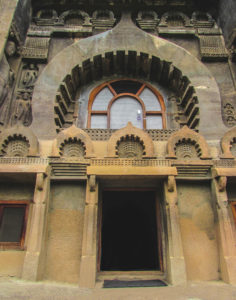Ajanta Caves are located at 107 km from Aurangabad district of Maharashtra State, India. It is a World Heritage monument, evolved during the period from 2nd Century B.C. to 6th Century A.D.
Discovery Of Ajanta Caves
A British Army’s young Captain Smith was on private tiger hunting expedition in summer of 1819. As he came near a spot on the hill from where the river Waghora emerged, he heard someone’s call. He turned back to see and it was a village shepherd boy, trying to tell him something with hand gestures. Smith understood that the boy was pointing to high cliff above the river and in no time, Smith understood that the tiger territory began across the river.
Smith began inching down the hill when he saw a patch of golden-red between a few stone-carved pillars or columns. Forgetting about the tiger, Smith charged towards the new target and soon he was inside Cave No 10. Captain John Smith marked his place in history as first European to stumble upon Ajanta Caves . Like other ancient inscriptions in the cave, he too inscribed with a knife on a pillar own “John Smith, 28th Cavalry, and 28th April, 1819”. Captain Smith, never imagined that, two hundred years later, he will be remembered for good in that he re-discovered the Ajanta caves and, little not good since he was also first to vandalise the paintings with own inscription.
Why Ajanta Caves are significant?
At Ajanta caves, the paintings on the walls, illustrate the events in the life of Prince Gautama Buddha, the founder of Buddhism and more popular Jataka stories pertaining to Buddha’s previous incarnation. According to the older conceptions, the Buddha did many deeds of kindness and mercy in a long series of transmigration as a Bodhisattva, before achieving his final birth as the sage of Sakyas (Sakyamuni). Incidentally, they contain the scenes of semi-mythological history, the royal court and popular life of the ancient times, as told in romances and plays.
The group of Ajanta caves is designated by the UNESCO as a WORLD HERITAGE MONUMENT in 1983. Inclusion in this list confirms the exceptional universal value of a cultural or natural site which deserves protection for the benefit of all humanity.
Location
Ajanta caves is situated in the Indhadree hills of the Western Ghats, in Maharashtra State of India.
Chronology of construction of Ajanta caves
- Cave 30 [2nd BC]
- Cave 8 -10, 12-13 [2nd-1st BC]
- Cave 11 [Second-third Centuries [400-450 A.D.]
- Cave 14-18 [Cave 5-7 [450-500 A.D.]
- Cave 1-2, 19-20 [ 500-550 A.D]
- Cave 21-24 26, [ 550-600 A.D]
- Cave 3-4, 25, 27-29 [600-650 A.D.]
Contribution of Satvahana’s
- The Satavahana period was in favour of Buddhism because the state was following catholic and tolerant policy towards all religions. The state had a positive approach towards Buddhism, both Hinayana and Mahayana. Buddhism spread on the state. However, the early Satavahana period was dominated by Hinayana religion and later period was dominated by Mahayana cult.
- The earliest caves at Ajanta belong to the Satavahana period. Chaitya caves 8. 9 and 10 and Vihara Caves 12 and 13 were constructed during their reign. The traders plying on the trade route also donated for cave building.
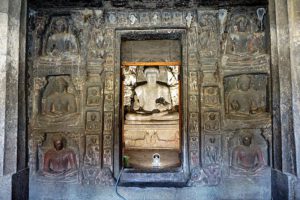
Cave 8 is an unfinished monastery at Ajanta, located at the lowest level and perhaps earliest among the monasteries. Major portion of the frontage has been swept away. It was probably a small monastery with a hall having two cells at each end and two at each side of the sanctum sanctorum.
Ajanta Cave 8 (Pc.- Wikimedia Commons)
Cave 9 is one of the oldest Chaitya of Ajanta belonging to Hinayana faith of Buddhism, dated to 1st century B.C. It rectangular on plan, but the layout of the twenty-three pillars on plan is apsidal dividing it into a nave, an apse and aisles.
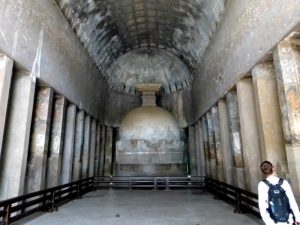
In April 1819, John Smith, a British Army Officer noticed the huge arch of this cave 10 from the view point which ultimately led to the discovery of Ajanta Caves. This cave is the earliest Chaityagrha at Ajanta. A Brahmi inscription on the façade dated to the 2nd century B.C. reads ‘Vasithiputa Kathahadi’.
The cave consists of two periods of paintings, the earlier dated to 2nd century B.C and the later 4th – 6th century A.D. The whole of this cave has been painted but only few painting were retained, which they were at one time completely adorned. Jataka stories of the earlier period, specially the Sama (Shama) Jataka and the Chaddanta Jataka are depicted lively.
Cave 12, the Hinayana monastery, is one of the oldest hewn and most probably belongs to 150 B.C. Its front wall has entirely disappeared. An inscription on the back wall of the monastery records the gift of this cave by one merchant Ghanamadada..
Cave 13 is a small monastery belonging to 1st century A.D. The hall has seven cells on three sides; each provided with two stone beds, one cell has raised stone pillows as well. The cells are so narrow that it is quite likely that they only served as dormitories (layanagriha). Cave was never painted.
Vakataka Kings and Ajanta Caves
The Mahayana Caves at Ajanta are finest and best due to royal patronage given by Vakataka Kings. Vakataka were related to Central King Chandragupta. Chandragupta II had daughter named Prabhavati whom she married to Vakataka Prince Rudrasena II under whose kingdom, the caves of Ajanta fell. If Gupta Kings are credited with Golden age in central part of India, Vakatakas brought the same in Deccan. The Vakataka dynasty was most glorious dynasty in South India.
To understand and appreciate the intentions of painters and sculptors at Ajanta, it is important to understand the social life of the Vakatakas around Ajanta.
- Ajanta paintings give us glimpses into various strata of society. Some people in paintings have been shown black in complexion and short in stature, with a flat nose. They may have been the aborigines of Vidarbha region, belonging to Naga race. Some of the painters and sculptors could be from this race as in various paintings; a Naga King with hoods of serpent over the head is painted. On the other hand, kings, queens, Brahmins, as well as male and female servants, noticed everywhere in frescoes, could be from Aryan race. They are fair in complexion, tall in stature, and graceful in features. In the frescos in
- Cave XVII, one notices in audience, listening to Buddha, some persons with conical head-dress, who could be foreigners. Those appearing elsewhere in paintings, with flat face and small eyes, dressed in a long robe, could be Chinese pilgrims, who came to India on visit to Buddhist sacred places.
- Ajanta painting also gives us the idea about the costumes and jewelries, worn by men and women in Vidarbha region of Vakatakas.
- In fresco representing the Mriga-Jataka, the king who has gone for hunting is shown dressed trousers and a long coat with full sleeves over them. Some servants are also shown with long-sleeved robes in Ajanta paintings.
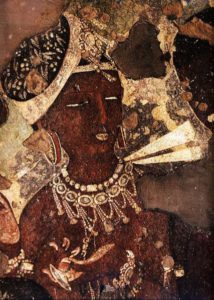
- Men usually wore an upper garment, which like a sacred thread, went over the left shoulder and below the right arm pit. In some paintings, the upper garment is seen turned over on the left shoulder. Some others are seen in a long cloth used as both, as a lower and an upper garment.
- In many paintings, the upper part of the bodies of kings and rich persons appear to be bare, while their servants, male and female, are clad in garments. Apparently it may appear strange to us but the intention of the painter must have been to project high status of them by showing them in transparent or see through cloths made of silk.
- Several modes of hair-dressing and coiffure are noticed in the paintings of Cave XVI and XVII.
- Women dressed their hair in a variety of ways. Nowhere the females are seen covering their faces with upper garment as is seen today in the area where some women cover their faces.
- Men used footwear which was tied with straps near the ankle.
Chaitya, Vihara and Stupa
- There are five Chaitya halls at Ajanta, out of which two belongs to Hinayana period. They are cave 10 and 9. Cave 10 is oldest in Ajanta group. It dates back to 2nd century B.C. Hinayana phase was simple excavation in which Chaitya and vihara were simple. The image of the Buddha was absent as Buddha was always represented symbolically.
- Mahayana vihara at Ajanta are cave 11, 7, 6, 15, 16, 17, 18 and 20 which belongs to 450 to 550 AD. Mahayana vihara is merely a dwelling for monks without a chapel attached to it. In Mahayana phase, Buddha was worshipped in the form of icon along with other gods and goddesses.
- The artist portrayed on the walls of Ajanta caves a number of gods and goddess of Buddhist pantheon and number of panels depicting the Jataka stories about the previous lives of the Buddha.
- The Ajanta Mahayana rock-cut monasteries display evidences of a growing appreciation of architectural values, and mark a distinct advance in the art evolution of the country. In Hinayana Chaitya cave 10, and 9, the stupa is simple with circumambulation passage. The stupa of 19 is crowded with sculptures and decorative motifs. The stupa of Ajanta cave 26 is lavishly carved with sculptures.
Sculptures & Paintings of Ajanta Caves
- Hinayana phase was simple excavation in which Chaitya and vihara were simple. The image of the Buddha was absent as Buddha was always represented symbolically.
- With the rise of Mahayana sect within Buddhism and after the influence of the Hindu Bhakti cult, a new tendency of image worship emerged. It affected Buddhist art greatly.
- Mahayana activity had greatly increased under Guptas due to their matrimonial alliances which resulted in impact of Gupta art in Ajanta sculptures. Gupta sculptures are characterized by a beautiful figures, a graceful pose and a charming expression.
- The Buddha and other images of Ajanta caves show high qualities like Buddha’s face shows the quality of serenity charm and great dignity. The faces of all the sculpture carved are very expressive. They show love and compassion. The most important among these are Naga figures, figure of Hariti and Panchika, Mahaparinirvana of Buddha, temptation scene of the Buddha etc.
- The temptation scene in cave 26 is very well executed. Every figure in this panel is beautifully cut. The Mahaparinirvana of Buddha in the same cave is magnificent.
- Two storied and three storied buildings are also found in Ajanta paintings. The palaces, balconies, courtrooms and bedrooms give an idea of the royal life of the time. The three dimensional effect given in painting indicate the keen observation and perfection in painting.
- A monastery in Sibi Jataka, painted in cave 17, shows perfect depth in construction of wooden structure and group of lady and gentlemen are shown standing in the hut. This effect is further clearly seen in the panel of Vidhurapandita Jataka painted on the right wall of cave 2. In this panel a couple is shown standing in the gallery which resembles like a part of royal palace. Above the gallery are shown the ladies engaged in discussions.
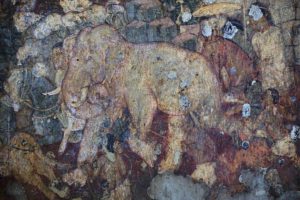
- There are many sculptures of Buddha in meditation found in different Ajanta caves. Buddha is seated on a raised platform in padmasana and is in teaching mudra. Two deers with a wheel are carved below. The greatness of Buddha is shown by hallow of knowledge and the Yaksha and Kinnaras with umbrella.
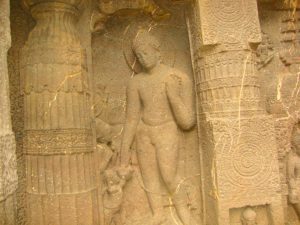
Bodhisattvas
- “Bodhi” is knowledge [enlightenment] and ‘Sattva’ is an essence. The Bodhisattva is one who becomes enlightened. However, he refuses to enter in state of Nirvana as he desires to guide all mankind on the path shown by Buddha, among popular Bodhisattvas, are Avlokiteshwara and Manjushri. Maitreya is future Buddha.
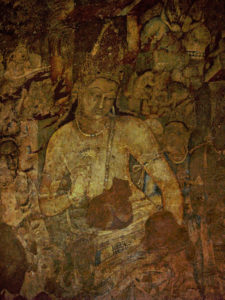
Earliest reference of Ajanta Caves
- There is a mystery about the ancient name of the Caves. The Buddhist text called Mahmayuri, mentions a village called Ajitanjaya, with its presiding Yakasha. The meaning of tiger in the local Marathi language is, Waghoba. The river Waghora could have been named after the tigers that were abundant in Ajanta valley.
- The only reference to the caves in ancient literature is that by Hieun Tsang, the celebrated Chinese pilgrim who stayed in India for 15 years in the first half of the seventh Century, when Ajanta was approaching its decline.
Jataka stories
- In Buddhist art, the Jataka stories were meant for illustrating the effect of Karma on the repeated births of man, ultimately leading to heaven or hell according to whether it was good or bad. They provided the subject-moral example of Buddhist behavior and illustrations of kind of complete self-abnegation for good of other so as to attain ultimate Buddhahood.
- Ajanta paintings and sculptures, is creation of artists and to understand what they try to convey, it is necessary to identify the subject they represent. However, over the centuries, most of the art is either deteriorated or damaged fully or partly.
- In Ajanta Cave No 20 and 21, a panel representing Buddha preaching before the congregation can be seen on the left wall. Of the themes that have been used for mural paintings of Ajanta, representation of the Jataka stories is prominent. These have been predominantly used on walls and entrances where sun light is available to observe the scenes easily.
- Pali Jataka collections mention about 547 stories on Buddha. In that Buddha is shown as ascetic 83 times, a monarch 58 times, the Deva of a tree 43 times, a religious teacher 26 times, a courtier, a prince and Brahmin priest 24 time each, and so on including- as nobleman, an ape, merchant, man of wealth, deer. Lion, swan, serpent, slave, fowl, horse, golden eagle, bull, peacock, potter and many more.
- The substance of all these Jataka stories is to exemplify the efforts the Bodhisattva made to develop virtues like liberality, forbearance, knowledge, generosity, truthfulness. The artist at Ajanta selected the virtues for their paintings based on what was relevant to the time. For example, the Chaddanta Jataka demonstrates Bodhisattva’s generosity. Vidhurapandita Jataka represents his wisdom.
- Although, identification of Jataka stories carved on sculptures and paintings have been difficult to identify, because of deterioration and damage, the researchers acknowledge presence of 23 Jataka stories.
Decline of rock-cut activities at Ajanta Caves
- King Harisena was the last glorious ruler of Vakataka. He was the master mind for reviving Buddhist art, at Ajanta. He was responsible for construction of as many as 25 Ajanta caves. He died, probably by heart attack, after ruling for seventeen years from 460 to 477 A.D.
- Harisena was followed by a young prince who was intelligent and accomplished in art but instead of walking on administrative and military path carved out by his illustrious father, the prince, after death of father, indulged in all kinds of vices and pleasures.
- By this time, the Central Gupta kings, who had matrimonial alliance with Vakataka also came under the attacks from Huns and the disintegration of empire began. India witnessed age of political instability where the feudatories began revolts. The royal patronage for Ajanta where rock-cut activities were going, on came under the resources crunch.
- At the same time around 470 A.D, the rule of Guptas at flourishing port of Broach and Sopara ended.
- The trade route from Ter-Pratisthana, Bhogvardhan, Ajanta and Ujjain also witnessed deserted trade activities. After the stoppage of royal patronage, the donations from the merchants carrying their goods, with sojourn at Ajanta also stopped.
- Period of seventy five years, after the end of Vakatakas to emergence of new strong kings around 550 A.D., it was dark period and the worst victim was Ajanta.
- By 550 A.D., new dynasty of Kalachuri emerged with capital at Mahismati. Ujjain in which was trade junction also came under their control. The Kalchuris extended their rule right upto the port of Sopora. New trade route replaced the one at Ajanta and shifted to Ellora to further connect to Ujjain through Pitalkhora caves. The sculptural and artistic activities again began under new rule and new trade route, but the beneficiary was not Ajanta but Ellora near Aurangabad and Elephant near Mumbai.
For 1300 years, Ajanta caves were completely forgotten until they were rediscovered by British Army Officer Captain Smith.
Also read-

